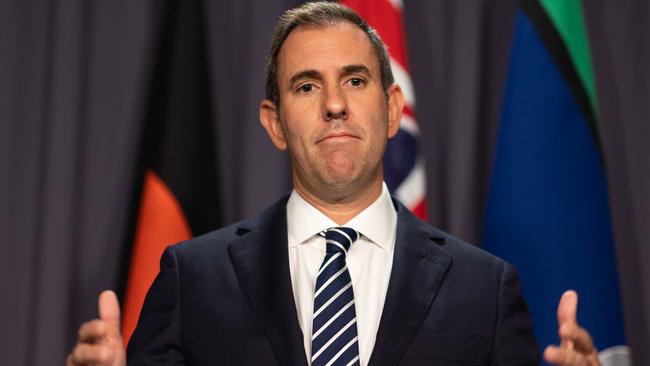Planned cap on super balances could force sale of investment properties
Forced sales in a falling property market would be the worst possible outcome of the ever-shrinking planned ‘cap’ on super.

Business
Don't miss out on the headlines from Business. Followed categories will be added to My News.
A cap on how much can be held in super accounts has sent a shudder through the investment market, especially among property investors.
Long-held fears that super is a lobster pot where assets could be trapped if governments meddle with policy are now a reality, as Treasurer Jim Chalmers plans a possible $3m limit per individual.
At its worst the move could trigger forced sales of property into a falling market as investors try to reorder their retirement plans.
Chalmers had committed the number-one sin in super: At a stroke he has destabilised a system that depends on certainty.
Even Garry Weaven, the original industry fund mastermind, is clearly uncomfortable with the escalating debate around new caps. Weaven told The Australian week the debate risks “undermining the whole basis of super”. You bet, Gary.

This debate started with an idea that $5m should be the most that can be kept in the system; at that point we were talking about the very top end of the market – a tiny group of 11,000 people whose presence works against the interests of the majority of investors.
But this week the figure moved down to $3m: Where does it go from here?
As a policy move, it has strong echoes of the franked dividend debacle during the ALP’s ill-fated Shorten era when everyday investors following lifelong plans discovered they were prime targets.
One thing is clear – property investors are going to be hit first with any changes here. As for self managed super funds they are sitting ducks.
As property analyst Pete Wargent told The Australian’s money cafe podcast this week, the repercussions of raiding super range far and wide.
Wargent made the point that anyone who decided to put their savings into super instead of into their home could soon feel like a chump. The capital gains tax shelter for your home remains in place; it is not in question. But – back to the lobster pot theory – super is now being “reviewed” which is shorthand for being made less attractive.
In theory, a $3m cap would ensnare 36,000 investors, but of course there are many more investors who are planning and putting their savings at risk to join that group in the years to come.
The majority of super savers with $3m in assets will have a SMSF and the majority of those funds will have property as the biggest allocation.
In property, $3m is, unfortunately, no longer big money. Put it this way, there are more than three million people who qualify as “sophisticated investors” where the criterion is $2.5m in assets.
In practical terms if a self managed super fund investor had $3.5m worth of property in any city and was living off the income, the income would be about 3 per cent. So that’s a gross income of $105,000. Sounds good!

But roughly half of those investors would have a complex range of running costs. There are rates and, depending on how unlucky they are, a menu of maintenance costs. In some states, such as Victoria, compliance costs are high.
If you were to include interest costs, the income on $3.5m would be nowhere near $105,000.
Many investors would be lucky to see their net income come in at half that figure.
Moreover, if this $3m rule comes into play, how does the investor go under the cap? You can’t sell a bedroom!
This is why a hard cap would mean forced sales. Just now, any forced sales would be into a falling market.
The alternative is to have yet another tax change in super – as if the system were not complicated enough.
Keep in mind this $3m cap is for the amount you could have in the super system. It is not the amount you can have tax free in the system that is already limited to $1.7m. At present, tax on earnings of up to $1.7m is zero and the tax is 15 per cent on the balance.
It is already a dreadfully complicated super system, but if the government does not demand the money over the $3m cap is removed, it will have to change the tax rules again.
At the SMSF national conference this week, Financial Services Minister Stephen Jones told the audience Labor was “not singling out the SMSF sector for attack”. Which is a bit like being told you are really valuable to the company when you have just been demoted.
One of the biggest ironies here – apart from the glaring irony that the ALP said it would not make any major changes to super – is that we are sitting in the middle of an unprecedented rental crisis.
About 90 per cent of all rental property is owned by private investors but new investors are already staying out of the market. Super changes will instantly work against SMSF investors going back into residential market property in particular.

So what can investors do – that is, investors who are still game to build retirement plans around property even though the rules never stop changing and are now poised to change again?
As many financial advisers point out, a new cap would effectively be retrospective. In other words it penalises anybody who is well advance in their plans before the change.
Either way you certainly can’t wind back the clock and restructure long-term plans now. You can’t, for example, put a property into joint names if it started out a few years ago in a single name – unless you want to enter a nightmare with the ATO.
However, if one partner in a couple has $1m today and might get to $3m on the day they retire while at the same time their spouse has say, $50,000, then you have time.
It’s early days and advisers are reluctant to go on the record but two strategies stand out.
First, for couples who are lucky enough to stay together long term it now makes even more sense to continually rebalance super assets so that one person does not cross current or future caps in super.
Second, most SMSFs have two trustees, invariably a married couple. For those willing to take the risk of widening their super fund, under new rules an SMSF can now have up to six members bringing the family into the fund and would then split the assets further and reduce present or future risks of breaking caps.
Or third, you could just stop trying – stop building wealth in super under guidelines that were supposed to be set in stone – and fall back on the pension.
What would the Treasurer think of that?
Originally published as Planned cap on super balances could force sale of investment properties



